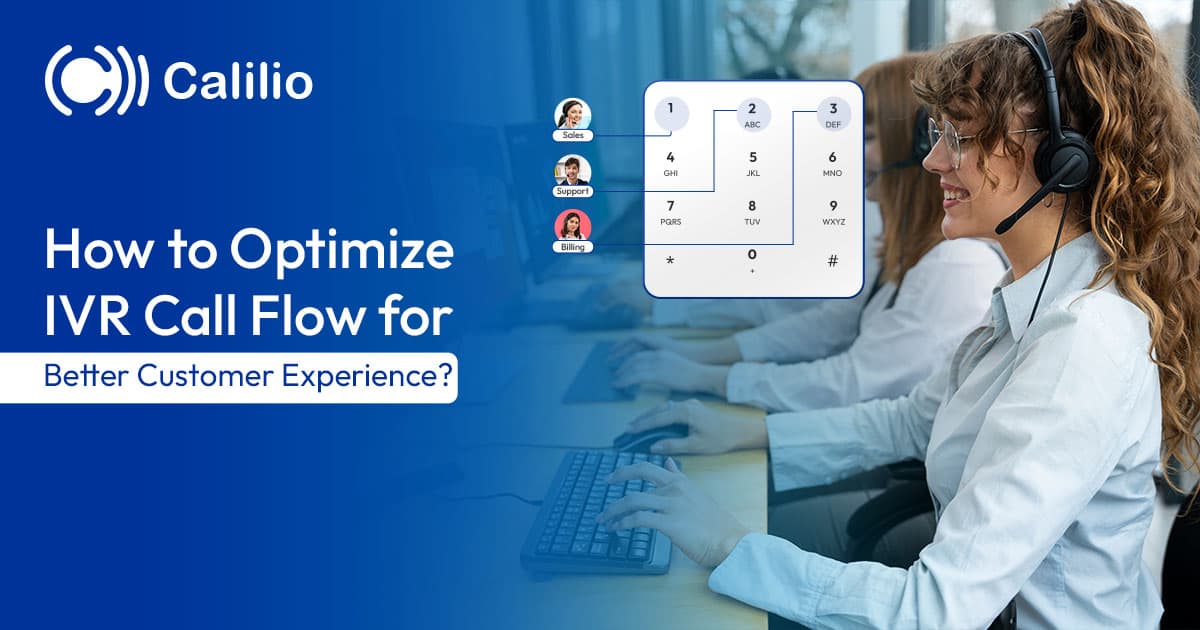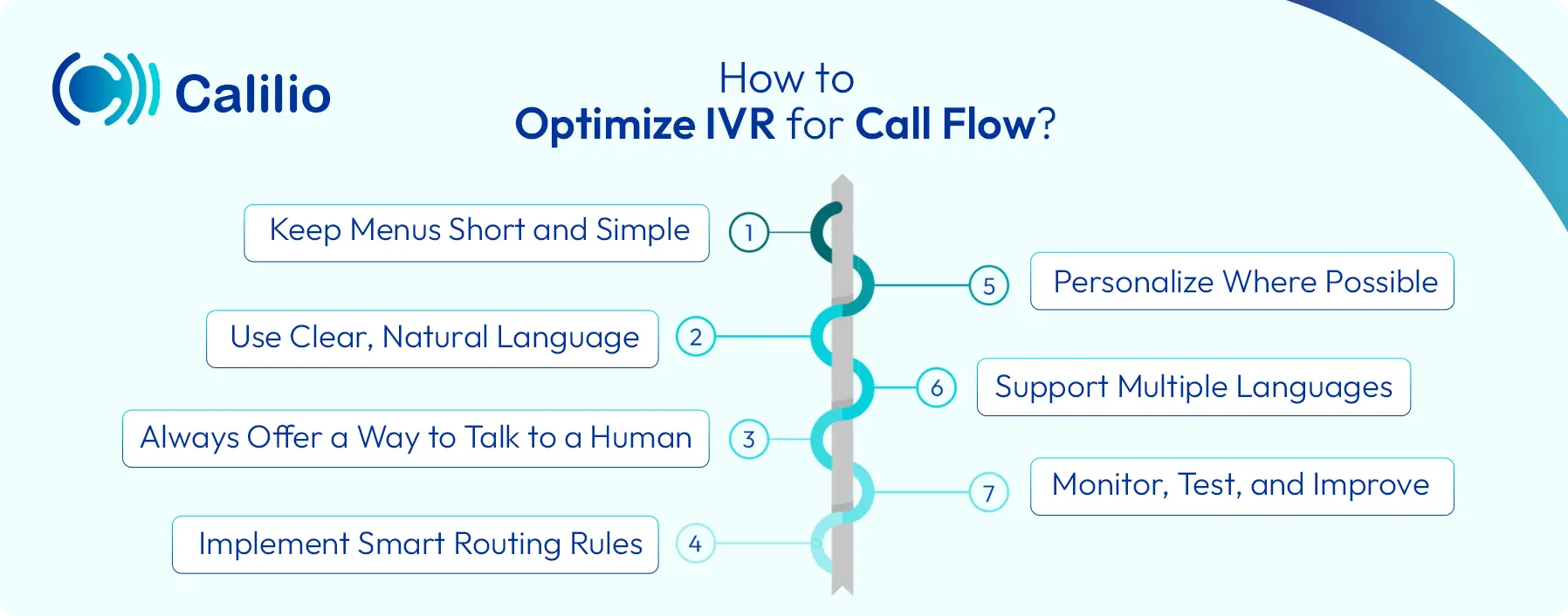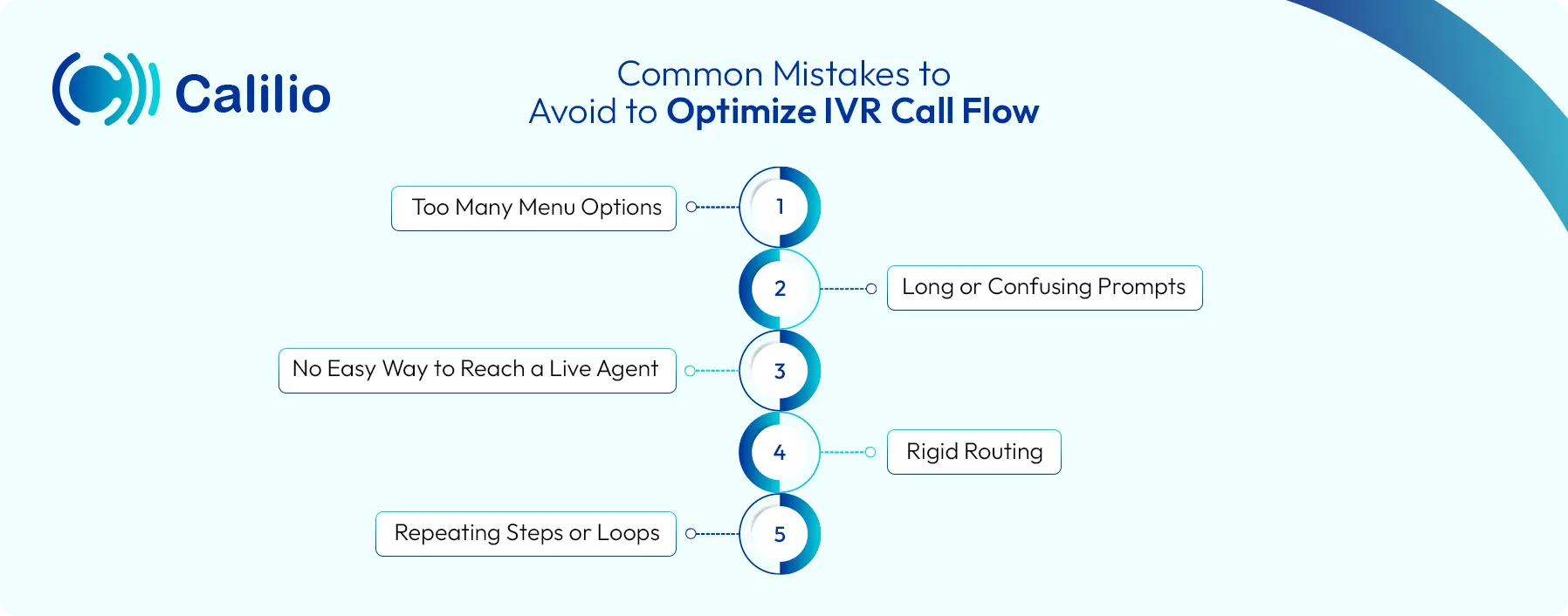How to Optimize IVR for the Best Call Flow?

Have you ever called a company and ended up stuck in a maze of confusing menu options of “Press 1 for sales, Press 2 for…”? All you wanted was quick help, but instead, you spent minutes pressing buttons, only to get more frustrated. Your customers feel the same way if your IVR is not optimized for the best call flow.
A poor IVR system doesn’t just annoy callers, it leads to dropped calls, unhappy customers, increased pressure on your support team, and a loss of loyal customers. Over time, that frustration can hurt your brand reputation, lower customer satisfaction, and even cost you business.
The good news? It’s fixable. In this guide, we’ll explore how you can optimize your IVR to achieve a smoother and more intelligent call flow. We’ll also cover examples of IVR call flows and common mistakes to avoid.
Key Highlights:
Call flow is the step-by-step path a customer takes when interacting with your phone system.
To deliver a seamless experience, your IVR should be designed with clarity and intention and continuously tested for improvement.
A well-optimized IVR enhances operational efficiency, reduces costs, and improves customer satisfaction, all while reinforcing your brand’s credibility.
Avoid overly complex menus, vague prompts, hidden agent options, rigid routing, and repetitive steps that frustrate callers.
Intelligent routing, personalized interactions, multilingual support, and regular updates are essential for creating an intuitive IVR system that effectively supports both your team and your customers.
Why Does Call Flow Optimization Matter?
Your Interactive Voice Response (IVR) system is often the first point of contact between your business and a customer, and first impressions count. When optimized properly, your IVR can do much more than just route calls. It can improve efficiency, reduce costs, and leave a lasting positive impression on your customers.
1. Improves First-Call Resolution (FCR)
When customers are routed to the right agent or department from the start, it’s easier for the agent to understand the issue and provide a quick solution. This reduces the need for multiple follow-ups and increases the likelihood of improving the first-call resolution rate.
2. Reduces Call Abandonment
Long wait times and confusing menus often lead to frustrated callers who hang up before getting help. A well-designed call flow keeps things fast and straightforward, keeping callers engaged and reducing abandoned calls.
3. Enhances Customer Experience
An optimized IVR delivers faster service, clearer options, and even personalized experiences. This shows customers that you respect their time, which in turn results in a positive interaction.
4. Boosts Agent Productivity
Intelligent IVR call routing sends the right calls to the right agents. It helps optimize agent workload, ensuring that no team member is overburdened while keeping performance balanced.
5. Enhances Your Brand Image
A clean, professional IVR system sets the tone for your business. It reflects that you’re organized, customer-focused, and committed to delivering great service, all before a human even picks up the phone.
Optimize Your Call Flow with Calilio
Route calls faster, reduce wait times, and effortlessly connect customers to the right agent.
How to Optimize IVR for Call Flow?
To optimize your IVR, keep menus short, use conversational language, offer a way to reach a live agent, provide support in multiple languages, and personalize with caller data. Also, continuously test and refine the IVR using analytics, A/B testing, and feedback to optimize performance and user satisfaction.

1. Keep Menus Short and Simple
Avoid overwhelming callers with too many options. Limit each menu to 4–5 clear choices, and keep the path to resolution as short as possible, ideally within two steps. Simple, focused menus help callers get where they need to go quickly and efficiently.
2. Use Clear, Natural Language
Your IVR should sound human, not robotic. Avoid using technical jargon or overly formal phrases and replace them with direct, friendly language.
Example: “Press 1 for Sales” is easier to understand than “To speak with a representative from the sales department, press 1.”
For an even better experience, consider using conversational IVR. It understands natural speech, allowing callers to speak in their own words, just like talking to a human. This makes interactions smoother, faster, and more comfortable for your customers.
3. Always Offer a Way to Talk to a Human
Some issues are too complex to be automated. Always include an option, such as “Press 0 to talk to a representative,” so callers can bypass the menu when needed.
4. Implement Smart Routing Rules
Modern IVR systems can do more than follow menus. Use intelligent routing to direct calls based on:
- Caller ID: Recognize repeat customers and personalize the flow.
- Time of Day: Route calls after business hours to voicemail or another number or the team.
- CRM Integration: Prioritize VIP customers or route based on account status.
5. Personalize Where Possible
Use existing customer data to enhance the relevance of the IVR experience. You can greet repeat callers by name, suggest shortcuts based on previous calls, or route them to their preferred agent or department.
6. Support Multiple Languages
If your business serves a multilingual audience, offer language options upfront. Don’t just offer multiple options in a language that callers may not understand. Use a multilingual IVR and allow users to select their preferred language immediately to minimize confusion and enhance the overall experience.
7. Monitor, Test, and Improve
Use call analytics, customer feedback, and recordings to spot drop-off points, identify confusing prompts, and test improvements with A/B testing for better IVR performance. Continuously refine and update your IVR flow based on real user behavior to enhance the caller experience and improve routing efficiency.
- A/B Test: Which voice prompt leads to faster resolution?
- Flow Simulation: Spot bottlenecks before going live.
- Analytics: Where do users drop off? Which paths are most used?
Examples of IVR Call Flows for Different Business Sizes
Forcing a multi-department business into a single-level IVR results in poor routing and confusion. Similarly, using a complex multi-level IVR for a small business creates unnecessary steps. The IVR structure should match your business needs, simple flows for small teams, and layered routing for larger operations.
Here are two examples to illustrate what type of IVR call flow you need for your business:
Single-Level IVR (Simple Businesses)
A single-level IVR offers a basic menu with a few straightforward options. It’s ideal for small businesses with limited services, especially in phone systems for local restaurants, consultants, or service-based freelancers. A single-level IVR ensures simplicity and speed, two things customers value most when they just want a quick answer or service.
Example: Local Restaurant
- “Thank you for calling Cafe.
- Press 1 to hear today’s menu.
- Press 2 to place an order
- Press 3 for our business hours.”
With just one level of options, the caller can quickly navigate to what they need, whether it’s checking hours or ordering food, without dealing with unnecessary complexity.
Benefits:
- Faster decision-making
- Reduced wait times
- Easier setup and maintenance
- Ideal for businesses with fewer departments or call types
Multi-Level IVR (Complex Organizations)
A multi-level IVR is built for larger businesses with multiple departments, complex services, or diverse customer inquiries. It uses a hierarchical menu structure to route calls more precisely.
Example: Hospital IVR Flow
- "Thank you for calling ABC Medical Center.
- Press 1 for appointments
→ Press 1 to schedule a new appointment
→ Press 2 to reschedule
→ Press 3 to check appointment status - Press 2 for billing inquiries
→ Press 1 for payment assistance
→ Press 2 for insurance questions - Press 3 for medical records
- Press 0 to speak with a representative.”
This structure guides the caller through multiple tiers to reach the exact department they need, reducing misrouted calls and saving both the caller and agent time.
Benefits:
- Handles high call volumes efficiently
- Supports detailed routing logic
- Allows better segmentation of customer needs
- Improves first-call resolution rates
Common Mistakes to Avoid to Optimize IVR Call Flow
Complex menus, unclear instructions, and hiding the option to speak with a live agent violate IVR best practices. Other issues, such as rigid routing and requiring callers to repeat information, can slow down resolution. To optimize call flow, your IVR should be simple, intuitive, and user-friendly.

Too Many Menu Options
When callers face too many choices, they quickly become overwhelmed and confused. It often leads to callers giving up and hanging up before reaching help.
Long or Confusing Prompts
Using technical terms, robotic language, or lengthy explanations can waste callers’ time and cause frustration. Clear, concise, and straightforward instructions keep callers engaged and minimize confusion.
No Easy Way to Reach a Live Agent
Many IVR systems hide the option to speak with a live person or don’t offer it at all, making callers feel stuck. Providing a clear and easy path to a live agent is essential to prevent callers from hanging up.
Rigid Routing
If your system ignores essential factors, such as the caller's identity, the time of day, or previous interactions, calls can be misdirected. This leads to longer wait times and slows down the resolution of problems.
Repeating Steps or Loops
Forcing callers to repeat the same information or go through the same options multiple times makes the experience feel impersonal and inefficient. A call flow should avoid unnecessary repetition for a seamless experience.
Conclusion
Optimizing your IVR for better call flow improves customer satisfaction and operational efficiency. A well-structured IVR guides callers smoothly, reduces wait times, and ensures they reach the right agents faster. Over time, it helps solve problems more quickly, reduces the number of dropped calls, and enhances your brand's reputation.
But when it’s not optimized, it can do just the opposite, increasing dropped calls and putting unnecessary pressure on your support team.
Frequently Asked Questions
What is a good IVR structure?
A good IVR structure is clear, concise, and easy to navigate. It should start with a friendly greeting, offer 4–5 main options, and provide a quick path to a live agent. The goal is to help callers find what they need in two steps or fewer, without feeling lost or frustrated.
How many options should an IVR menu have?
How can AI improve IVR call flow?

Still have questions?
Can’t find the answer you’re looking for? Please chat with our friendly team.
Stay in the loop
Get the latest call insights, trends, and updates delivered straight to your inbox.
By subscribing, you agree to receive updates from Calilio.
You can unsubscribe anytime.


